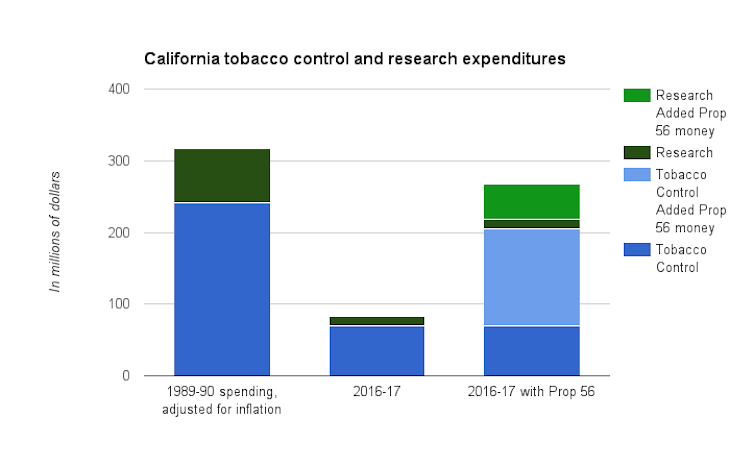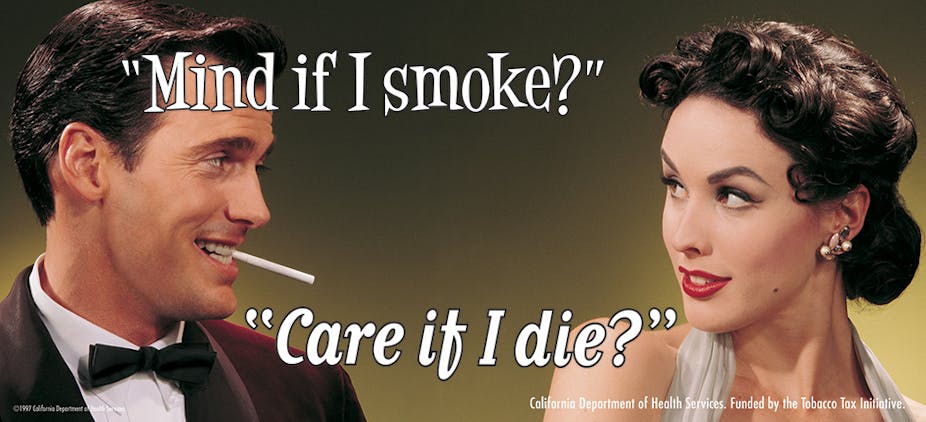Public health and medical advocates have been working for nearly two years to increase California’s tobacco tax, one of the nation’s lowest, by US$2.00. The current tax, a mere 87 cents a pack, ranks close to tobacco-growing states like Kentucky.
The proposal that will be on the ballot in November as Proposition 56 , the California Healthcare, Research and Prevention Tobacco Tax Act of 2016, allocates most of the revenue to pay for expanded medical services for poor people through Medicaid, known as MediCal in California.
More important, it includes crucial funds to reinvigorate California’s aggressive and effective, but fading, tobacco control and research programs.
Heart disease, stroke, lung disease, cancer and other tobacco-induced diseases kill more people than car accidents, murder, suicide, alcohol, illegal drugs and AIDS combined. As director of the University of California San Francisco Center for Tobacco Control Research and Education, I study smoking. I also study – and have felt – the effects of the powerful tobacco lobby. I know what the tobacco companies have done in the past and can see what they are doing in California to block this proposal.
Californians voters can show the rest of the country how to stand up to out-of-state bullies Philip Morris and RJ Reynolds and improve the lives of millions.
Aggressive efforts worked, so Big Tobacco fought back

Health advocates had to go to the trouble and expense of putting this on the ballot because tobacco companies dominate the legislature. Despite 35 attempts by health advocates in the last 34 years, the legislature has raised the tobacco tax only once – by just 2 cents, in 1993 – since 1967. With a tax of just 87 cents per pack of cigarettes, California, the country’s most populous state, ranks 37th among the states in its tobacco tax.
California is one of only three states that has not raised its tobacco tax in the 21st century. California’s cigarette tax is so low that even with a $2 increase it would still only rank only ninth.
Big Tobacco ponied up $36 million to get started
On July 12, 2016, Philip Morris and RJ Reynolds finally appeared when they coughed up $17 million to create “No on 56 - Stop the Special Interest Tax Grab. Major Funding by Philip Morris USA Inc. and R.J. Reynolds Tobacco Company, with a Coalition of Taxpayers, Educators, Healthcare Professionals, Law Enforcement, Labor, and Small Businesses.” And on August 5, they put in another $19 million, bringing their total so far to fight Proposition 56 to $36 million.
The “No” campaign, as usual, is not what it appears to be. To date, not a penny has come from “taxpayers, educators, health care professionals, law enforcement, labor or small businesses.” The only reason Philip Morris and RJ Reynolds included their names in the committee name is that California’s strong campaign finance disclosure law requires top donors – in this case the only donors – be identified. Normally, the tobacco companies stay in the shadows.
For comparison, North Dakota’s 44-cent tobacco tax is even lower than California’s, ranking 47th. Like California, health advocates have mounted an initiative to raise it to $2.20. But because North Dakota lacks California’s strong public disclosure law, Philip Morris (Altria) and RJ Reynolds left names off “North Dakotans Against the 400% Tax Increase” despite dropping $859,873 so far to oppose that initiative.

And what is the cigarette companies’ leading argument against the California initiative? They complain, “Prop 56 allocates just 13 percent of new tobacco tax money to treat smokers or stop kids from starting.” And “If we are going to tax smokers another $1.4 billion per year, more should be dedicated to treating them and keeping kids from starting.”
This is a smart argument for the companies to make. Research has consistently shown it is their smartest argument.
Yet, while it may be their smartest argument, it does not always work. In 1988, health advocates successfully defended another initiative, Proposition 99, against the industry front group Californians Against Unfair Tax Increases. (That was before California passed the law requiring big money behind initiative campaigns identify themselves in their advertising.)
Proposition 99 allocated 5 cents of the 25-cent tax to support the largest, most aggressive and effective tobacco control campaign ever done. Unlike past government campaigns, it did not focus on kids or smokers. The California Tobacco Control Program directly confronted Big Tobacco and educated the public about secondhand smoke nicotine addiction. It focused on the nonsmoking majority to reinforce the nonsmoking social norm.
Industry running scared
And the results were stunning: Smoking dropped so fast between 1989 and 1997 that 58,900 deaths from heart disease were prevented. And 11,000 cases of lung cancer were prevented by 1999.
By 2009, the reductions in smoking had saved Californian citizens, taxpayers and businesses $134 billion in health care costs.
It also cost Big Tobacco $28.5 billion in lost sales.
Philip Morris and RJ Reynolds know this, which is why they have used their muscle in the legislature to fight every penny spent on tobacco control since voters passed Proposition 99.
Indeed, they did everything they could to divert money away from tobacco prevention efforts into paying for the very medical services they trumpet in their campaign against Proposition 56. After all, treating heart attacks doesn’t reduce cigarette sales.
Tax increase needed to help smokers and nonsmokers
Since 1988, inflation has eroded the value of the five cents a pack that Proposition 99 allocated to California’s tobacco control program. In 1989-90, the program’s first year, the Tobacco Control Program received $242 million (in 2016 dollars) compared to just $70 million now.
The result is that the program is losing its effectiveness because the impact is directly related to how much money goes to fight Big Tobacco.
At the same time, the innovative research program Proposition 99 created saw its resources drop from $41 million in 1989-90 (in 2016 dollars) to $13 million now.

Proposition 56 is the opportunity to restore lost ground on tobacco control programs.
According to the California legislature’s nonpartisan Legislative Analyst, Proposition 56 provides $135 million to anti-tobacco education and $50 million to research. This money would bring funding for the anti-tobacco education to $205 million and research to $63 million, restoring 85 percent of the programs’ purchasing power.
These resources, combined with the price increase that will accompany the tax, will cut smoking. Our analysis of a $1 tobacco tax that the industry (barely) defeated in 2012 estimated that the combined effect of the tax and reinvigorated anti-tobacco campaign would have cost Philip Morris, RJ Reynolds and other tobacco companies a billion dollars a year.
Improving the economy and creating jobs
Reducing smoking benefits more than health. Eighty cents of every dollar spent on cigarettes leaves California to tobacco companies (and a few farmers) back East. When people quit smoking, they don’t burn the money, they spend it. And because less leaves the state, more of their money gets recycled in California, where it creates local economic activity and jobs.
The billion dollars a year that would have not been spent on tobacco had the 2012 tax passed would have led to $1.9 billion in economic activity and 12,000 new jobs.
Because Proposition 56 is a bigger tax with more money for anti-tobacco education and research it will have a bigger effect on health, reducing medical costs and building the California economy … and cost Big Tobacco even more money.
So, I doubt that Philip Morris and RJ Reynolds are really investing tens of millions to oppose Proposition 56 because they want to see more spent on smoking reduction.
Smoke-free society is in reach
In 2014 only 11.7 percent of Californians smoked, and among them, two-thirds (65 percent) were smoking 10 cigarettes or less daily with one-third (37 percent) not even smoking every day.
If voters see through Philip Morris and RJ Reynolds’ disingenuous campaign and vote Yes on Proposition 56, they will reinvigorate the state’s tobacco control program. The bottom line? California could become the first state to reach former Surgeon General C. Everett Koop’s vision of a smoke-free society.

